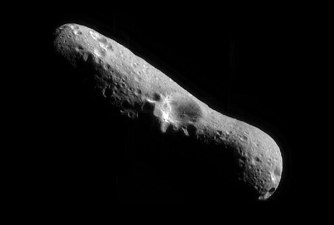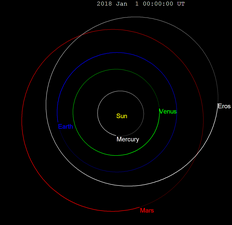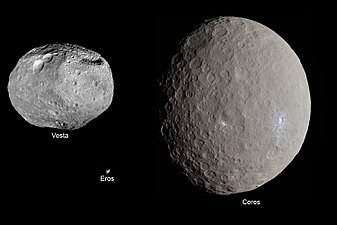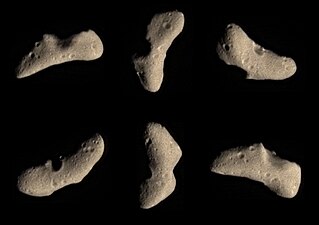433 Eros
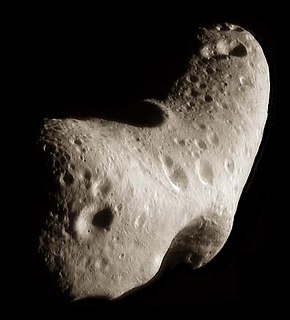 Eros – composite image of the north polar region, with thecratersPsyche above andHimerosbelow. The long ridge Hinks Dorsum, believed to be athrust fault,can be seen snaking diagonally between them. The smaller crater in the foreground is Narcissus.Watters, (2011) | |
| Discovery [1] | |
|---|---|
| Discovered by | C. G. Witt |
| Discovery site | Berlin Urania Obs. |
| Discovery date | 13 August 1898 |
| Designations | |
| (433) Eros | |
| Pronunciation | /ˈɪərɒs/[2] |
Named after | Ἔρως,Érōs[3] |
| |
| Adjectives | Erotian/ɛˈroʊʃ(i)ən/ |
| Symbol | |
| Orbital characteristics [1] | |
| Epoch4 September 2017 (JD2458000.5) | |
| Uncertainty parameter0 | |
| Observation arc | 53.89 yr (19,683 days) |
| Earliestprecoverydate | 29 October 1893 |
| Aphelion | 1.7825AU |
| Perihelion | 1.1334 AU |
| 1.4579 AU | |
| Eccentricity | 0.2226 |
| 1.76yr(643 days) | |
| 71.280° | |
| 0° 33m35.64s/ day | |
| Inclination | 10.828° |
| 304.32° | |
| 178.82° | |
| EarthMOID | 0.1505 AU (58.6LD) |
| MarsMOID | 0.2407AU |
| Physical characteristics | |
| Dimensions | |
| Mass | (6.687±0.003)×1015kg[4] |
Meandensity | 2.67±0.03 g/cm3[1][4] |
| 5.270h[1] | |
| 0.25±0.06[1] | |
| 7.0–15[6] | |
| 11.16[1] | |
433Erosis astonyasteroidof theAmor group,and the first discovered, and second-largestnear-Earth object.It has an elongated shape and avolume-equivalent diameterof approximately 16.8 kilometers (10.4 miles).Visitedby theNEAR Shoemakerspace probe in 1998, it became the first asteroid ever studied from its own orbit.
The asteroid was discovered by German astronomerC. G. Wittat theBerlin Observatoryon 13 August 1898 in aneccentric orbitbetween Mars and Earth. It was later named afterEros,a god fromGreek mythology,the son ofAphrodite.He is identified with the planetVenus.[3]
History
[edit]Discovery
[edit]Eros was discovered on 13 August 1898 byCarl Gustav WittatBerlin Urania ObservatoryandAuguste CharloisatNice Observatory.[7]Witt was taking a two-hour exposure ofbeta Aquariito secure astrometric positions of asteroid185 Eunike.[8]
Name
[edit]Eros is named after theGreek godoflove,Erōs.It was the first minor planet to be given a male name;[3]the break with earlier tradition was made because it was the first near-Earth asteroid discovered.
Later studies
[edit]During the opposition of 1900–1901, a worldwide program was launched to makeparallaxmeasurements of Eros to determine thesolar parallax(or distance to the Sun), with the results published in 1910 byArthur HinksofCambridge[9]andCharles D. Perrineof theLick Observatory,University of California.[10]Perrine published progress reports in 1906[11]and 1908.[12]He took 965 photographs with theCrossley Reflectorand selected 525 for measurement.[13]A similar program was then carried out, during a closer approach, in 1930–1931 byHarold Spencer Jones.[14]The value of theAstronomical Unit(roughly the Earth-Sun distance) obtained by this program was considered definitive until 1968, whenradaranddynamical parallaxmethods started producing more precise measurements.
Eros was the first asteroid detected by theArecibo Observatory's radar system.[15][16]
Eros was one of the first asteroids visited by a spacecraft, the first one orbited, and the first one soft-landed on.NASAspacecraftNEAR Shoemakerentered orbit around Eros in 2000, and landed in 2001.
Mars-crosser
[edit]Eros is aMars-crosser asteroid,the first known to come within the orbit ofMars.Objects in such an orbit can remain there for only a few hundred million years before the orbit isperturbedby gravitational interactions.Dynamical systemmodeling suggests that Eros may evolve into anEarth-crosserwithin as short an interval as two million years, and has a roughly 50% chance of doing so over a time scale of 108~109years.[17]It is a potential Earthimpactor,[17]about five times larger than the impactor that createdChicxulub craterand led to theextinction of the non-avian dinosaurs.[a]
NEAR Shoemakersurvey and landing
[edit]TheNEAR Shoemakerprobe visited Eros twice, first with a briefflybyin 1998, and then by orbiting it in 2000, when it extensively photographed its surface. On 12 February 2001, at the end of its mission, it landed on the asteroid's surface using its maneuvering jets.
This was the first time a Near Earth asteroid was closely visited by a spacecraft.[18]
-
Animation of NEAR Shoemaker trajectory from 19 February 1996 to 12 February 2001..
-
Animation ofNEAR Shoemaker'strajectory around 433 Eros from 1 April 2000 to 12 February 2001.
NEAR Shoemaker·433 Eros
Physical characteristics
[edit]Surface gravitydepends on the distance from a spot on the surface to the center of a body's mass. Eros's surface gravity varies greatly because Eros is not a sphere but an elongated peanut-shaped object. The daytime temperature on Eros can reach about 100 °C (373 K) atperihelion.Nighttime measurements fall near −150 °C (123 K). Eros's density is 2.67g/cm3,about the same as the density of Earth's crust.
NEAR scientists have found that most of the larger rocks strewn across Eros were ejected from a singlecraterin an impact approximately 1 billion years ago.[19](The crater involved was proposed to be named "Shoemaker", but is not recognized as such by theInternational Astronomical Union(IAU), and has been formally designated Charlois Regio.) This event may also be responsible for the 40 percent of the Erotian surface that is devoid of craters smaller than 0.5 kilometers across. It was originally thought that the debris thrown up by the collision filled in the smaller craters. An analysis of crater densities over the surface indicates that the areas with lower crater density are within 9 kilometers of the impact point. Some of the lower density areas were found on the opposite side of the asteroid but still within 9 kilometers.[20]
It is thought thatseismicshockwaves propagate through the asteroid, shaking smaller craters into rubble. Since Eros is irregularly shaped, parts of the surface antipodal to the point of impact can be within 9 kilometres of the impact point (measured in a straight line through the asteroid) even though some intervening parts of the surface are more than 9 kilometres away in straight-line distance. A suitable analogy would be the distance from the top centre of a bun to the bottom centre as compared to the distance from the top centre to a point on the bun's circumference: top-to-bottom is a longer distance than top-to-periphery when measured along the surface but shorter than it in direct straight-line terms.[20] Compression from the same impact is believed to have created thethrust faultHinks Dorsum.[21]
A phenomenon nameddust pondswere discovered in the asteroid in October 2000. Dust ponds are a phenomenon where pockets of dust are seen in airless Celestial bodies. These are smooth deposits of dust accumulated in depressions on the surface of the body (like craters), contrasting from the Rocky terrain around them.[22]They typically have different color andalbedocompared to the surrounding areas. The asteroid contains lots of large craters more than 200 m in diameter. Their number is near to the saturation point of these craters. But craters smaller than that are relatively low. Suggesting that some process of erasure has covered them up. The floors of some craters are covered with smooth and flat areas (less than 10° slope). Suchdust pondsare characterized by slightly bluer colour compared to the surrounding terrain. 334 of such ponds are identified, with a diameter of 10m. 255 of these are larger than 30m, and 231 (or 91%) are found within 30° from Equator.
Data from the Near Earth Asteroid Rendezvous spacecraft collected on Eros in December 1998 suggests that it could contain 20 billion tonnes of aluminum and similar amounts of metals that are rare on Earth, such as gold and platinum.[23]
Visibility from Earth
[edit]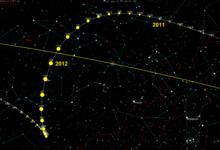
On 31 January 2012, Eros passed Earth at 0.17867AU(26,729,000km;16,608,000mi),[24][25]about 70 times thedistance to the Moon,with avisual magnitudeof +8.1.[26]During rare oppositions, every 81 years, such as in 1975 and 2056, Eros can reach a magnitude of +7.0,[6]which is brighter thanNeptuneand brighter than anymain-belt asteroidexcept1 Ceres,4 Vestaand, rarely,2 Pallasand7 Iris.Under this condition, the asteroid actually appears to stop, but unlike the normal condition for a body in heliocentric conjunction with Earth, itsretrogrademotion is very small. For example, in January and February 2137, it moves retrograde only 34 minutes in right ascension.[1]
In popular culture
[edit]In the novel and television seriesThe Expanse,a catastrophic science experiment is unleashed on a civilian population living within tunnels cut through Eros. This so-called "Eros Incident" ends with the asteroid mysteriously breaking its usual orbit and crashing intoVenus.[27]
It makes an appearance in the novel (and itsfilm adaptation)Ender's GamebyOrson Scott Card,serving as a base for humanity and the location of Command School after having been captured from the invading aliens (the Formics) prior to the initial novel who had used the asteroid as their forward operating base in their previous invasion.[28]
In theSpace Angelepisode 'Visitors from Outer Space' (title text not quite matching narration), Scott McCloud and his crew are forced to destroy Eros by deflecting it into theSun,after it becomes a hazard to spacecraft navigation.[29]
It is the setting for the entirety of the plot of the novelCaptive UniversebyHarry Harrison.
Gallery
[edit]-
Animation of the rotation of Eros
-
View from one end of Eros across the gouge on its side towards the opposite end
-
First mosaic image of Eros taken from an orbiting spacecraft
-
Mosaic image of Eros
-
At 4.8 km (3.0 mi) across, the crater Psyche is Eros's second largest.
-
Regolithof Eros, seen during NEAR's descent; area shown is about 12 meters (40 feet) across
-
Orbital diagram of Eros with locations on 7 May 2013
-
Orbital diagram of Eros with locations on 1 January 2018
-
Six views of Eros in approximate natural color fromNEAR-Shoemakerin February 2000
-
Stereo image of Eros
See also
[edit]Notes
[edit]- ^Ratio of mean diameters is 16.84 km/~10 km; the volume ratio is approximately 4.8 (cubed value).
References
[edit]- ^abcdefghijklm433 Eros (1898 DQ).JPL Small-Body Database Browser(last obs.).Jet Propulsion Laboratory.4 June 2017.Archivedfrom the original on 11 July 2020.Retrieved16 August2017.
- ^"Eros".Oxford English Dictionary(Online ed.).Oxford University Press.(Subscription orparticipating institution membershiprequired.)
- ^abcSchmadel, Lutz D. (2007). "(433) Eros".Dictionary of Minor Planet Names.Springer Berlin Heidelberg.p. 50.doi:10.1007/978-3-540-29925-7_434.ISBN978-3-540-00238-3.
- ^abc Yeomans, D.K.; Antreasian, P.G.; Barriot, J.-P.; Chesley, S.R.; Dunham, D.W.; Farquhar, R.W.; et al. (September 2000). "Radio science results during the NEAR-Shoemaker spacecraft rendezvous with Eros".Science.289(5487): 2085–2088.Bibcode:2000Sci...289.2085Y.doi:10.1126/science.289.5487.2085.ISSN0036-8075.PMID11000104.
- ^ Baer, Jim (2008)."Recent asteroid mass determinations".earthlink.net(personal website). Archived fromthe originalon 29 January 2009.Retrieved11 December2008.
- ^ab"NEODys (433) Eros ephemerides for 2137".Department of Mathematics. Pisa, Italy: University of Pisa.Archivedfrom the original on 1 December 2022.Retrieved27 June2010.
- ^ Scholl, Hans;Schmadel, Lutz D. (2002). "Discovery circumstances of the first near-Earth asteroid (433) Eros".Acta Historica Astronomiae.15:210–220.Bibcode:2002AcHA...15..210S.
- ^ Yeomans, Donald K. (2014).Asteroid 433 Eros: The target body of the NEAR Mission(PDF).Jet Propulsion Laboratory(Report).California Institute of Technology.Archived fromthe original(PDF)on 28 September 2007.
- ^Hinks, A.R.(1909)."Solar Parallax Papers no. 7: The general solution from the photographic right ascensions of Eros, at the opposition of 1900".Monthly Notices of the Royal Astronomical Society.69(7): 544–67.Bibcode:1909MNRAS..69..544H.doi:10.1093/mnras/69.7.544.Archivedfrom the original on 26 July 2020.Retrieved5 September2019.
- ^ Perrine, Charles D.(1910). Determination of the solar parallax from photographs of Eros made with the Crossley reflector of the Lick Observatory, University of California (Report). Washington, DC:Carnegie Institution of Washington.pp. 1–104.
- ^ Perrine, C.D.(1906). "The measurement and reduction of the photographs of Eros made with the Crossley Reflector in 1900".Publications of the Astronomical Society of the Pacific.18(10): 226.
- ^ Perrine, Charles D.(1908)."Progress on the Crossley Eros solar parallax work".Publications of the Astronomical Society of the Pacific.20(120): 184.Bibcode:1908PASP...20..184P.doi:10.1086/121816.S2CID121782316.
- ^ Campbell, W.W. (1906). "Reports of the observatories: Lick Observatory".Publications of the Astronomical Society of the Pacific.19(113): 92.
- ^ Jones, H.S.(1941). "The solar parallax and the mass of the Moon from observations of Eros at the opposition of 1931".Memoirs of the Royal Astronomical Society.66:11–66.
- ^ Butrica, Andrew J. (1996).To See the Unseen: A history of planetary radar astronomy(2nd ed.). Washington, DC:National Aeronautics and Space Administration.p.224.ISBN978-0160485787.
- ^"Introduction to asteroid radar astronomy".Los Angeles, CA:University of California, Los Angeles.Archivedfrom the original on 19 May 2014.Retrieved19 May2014.
- ^ab Michel, Patrick; Farinella, Paolo; Froeschlé, Christiane (25 April 1996). "The orbital evolution of the asteroid Eros and implications for collision with the Earth".Nature.380(6576): 689–691.Bibcode:1996Natur.380..689M.doi:10.1038/380689a0.S2CID4354612.
- ^Svitil, Kathy A. (February 2001)."The end is near: The remarkable journey of a tough little space probe to the place where killer asteroids lurk".Discover Magazine.Archivedfrom the original on 1 September 2020.Retrieved30 September2019– via DiscoverMagazine.
- ^ Thomas, P.C.; Veverka, J.; Robinson, M.S.; Murchie, S. (27 September 2001). "Shoemaker crater as the source of most ejecta blocks on the asteroid 433 Eros".Nature.413(6854): 394–396.Bibcode:2001Natur.413..394T.doi:10.1038/35096513.ISSN0028-0836.PMID11574880.S2CID4325299.
- ^ab Thomas, P.C.; Robinson, M.S. (21 July 2005). "Seismic resurfacing by a single impact on the asteroid 433 Eros".Nature.436(7049): 366–369.Bibcode:2005Natur.436..366T.doi:10.1038/nature03855.PMID16034412.S2CID4425770.
- ^ Watters, T.R.; Thomas, P.C.; Robinson, M.S. (2011). "Thrust faults and the near-surface strength of asteroid 433 Eros".Geophysical Research Letters.38(2): L02202.Bibcode:2011GeoRL..38.2202W.doi:10.1029/2010GL045302.ISSN0094-8276.
- ^"Eros's puzzling surface".skyandtelescope.org.Archivedfrom the original on 18 October 2023.Retrieved18 October2023.
- ^"Gold rush in space?".BBC News.Archivedfrom the original on 24 July 2020.Retrieved13 December2014.
- ^433 Eros (1898 DQ)(last obs). JPL Close-Approach Data. 13 November 2011.Archivedfrom the original on 24 July 2020.Retrieved14 November2011.
- ^"NEODyS-2 close approaches for (433) Eros".NEODyS-2 Near Earth Objects.European Space Agency/University of Pisa/ Space Dynamics Service S.R.L.Archivedfrom the original on 25 July 2020.Retrieved14 November2011.
- ^"AstDys (433) Eros ephemerides for 2012".Department of Mathematics. Pisa, Italy: University of Pisa.Archivedfrom the original on 25 July 2020.Retrieved27 June2010.
- ^Scott Snowden (13 December 2019)."'The Expanse': Here's a Recap of Seasons 1-3 Ahead of Season 4 on Amazon Prime ".Space.Archivedfrom the original on 30 November 2022.Retrieved18 December2022.
- ^Ender's Game and Philosophy: The Logic Gate is Down.John Wiley & Sons. 2013. p. 117.
- ^"Space Angel VISITORS FROM OUTER SPACE".2 December 2013.Archivedfrom the original on 14 November 2022.Retrieved18 December2022– via youtube.
Further reading
[edit]- Clark, C.S.; Clark, P.E. (13–17 March 2006).Using boundary-based mapping projections to reveal patterns in depositional and erosional features on 433 Eros.37th Annual Lunar and Planetary Science Conference. League City, Texas. p. 1189.Bibcode:2006LPI....37.1189C.Abstract no.1189.
- Riner, M. A.; et al. (November 2008). "Global survey of color variations on 433 Eros: Implications for regolith processes and asteroid environments".Icarus.198(1): 67–76.Bibcode:2008Icar..198...67R.doi:10.1016/j.icarus.2008.07.007.
External links
[edit]This section'suse ofexternal linksmay not follow Wikipedia's policies or guidelines.(October 2018) |
- NEAR Shoemaker spacecraft
- NEAR image of the day archive
- Movie: NEAR Shoemaker spacecraft landing
- The Eros Project(OrbDev's attempts at litigation over their property claim)
- 3D VRML 433 Eros Model
- 3D shape model of Eros(requires WebGL)
- NEODys(saved output file from 2007)showing distance and magnitude Ephemerides for Eros during rare oppositions
- The Chicxulub DebateIn relation to the K-T extinction.
- Dearborn Observatory Records, Northwestern University Archives, Evanston, IllinoisNotations as to historical archived work on asteroid 433 Eros.
- Eros at Opposition in 2012(Royal Astronomical Society of New Zealand)
- NEAR database by ASU(Image search) (Example)
- Eros nomenclatureandEros map with feature namesfrom theUSGS planetary nomenclature page
- 433 ErosatNeoDyS-2, Near Earth Objects—Dynamic Site
- 433 ErosatAstDyS-2, Asteroids—Dynamic Site
- 433 Erosat theJPL Small-Body Database





